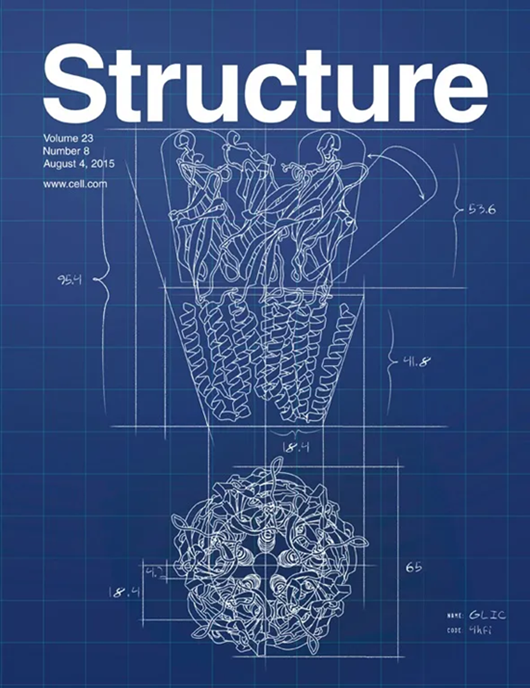Secondary chelation through shared water provides ion selectivity in bacterial sodium channels
IF 4.3
2区 生物学
Q2 BIOCHEMISTRY & MOLECULAR BIOLOGY
引用次数: 0
Abstract
Selective ion conductance through sodium channels has been intensely investigated for decades. Here, we focus on the sodium and potassium hydration shell structure and propose the mechanism of Na+ over K+ selectivity in the bacterial sodium channel NavMs. We suggest that the channel selectivity filter forms hydrogen bonds with Na+ hydration shell in a perfect octahedral stereometry, which mimics bulk water and provides high Na+ conductance. Using molecular dynamics simulations, we reveal a conserved ion-binding site formed by carboxyl/carbonyl groups, where both Na+ and K+ remain fully hydrated. While passing through the selectivity filter, Na+ octahedral shell remains unhindered, while K+ square antiprismatic shell is squeezed, creating an energy barrier for K+ current. In contrast to K+-channels, where the selectivity filter interacts with the permeating ions directly (“primary” chelation), NavMs gropes the ion hydration shell, performing “secondary” chelation. This ion recognition mechanism is probably widespread in other channels and pores.

通过共享水的二级螯合作用在细菌钠离子通道中提供离子选择性
几十年来,钠离子通道的选择性离子电导一直被广泛研究。本文主要研究了钠离子和钾离子的水合壳结构,并提出了细菌钠离子通道NavMs中Na+对K+选择性的机制。我们认为通道选择性过滤器与Na+水化壳形成一个完美的八面体立体氢键,模拟了大量的水,并提供了高Na+电导率。通过分子动力学模拟,我们发现了一个由羧基/羰基形成的保守结合位点,其中Na+和K+保持充分水合。当通过选择性滤波器时,Na+八面体壳层保持不受阻碍,而K+方形反棱镜壳层被挤压,形成K+电流的能垒。与K+通道相反,选择性过滤器直接与渗透离子相互作用(“初级”螯合),NavMs摸索离子水合壳,进行“次级”螯合。这种离子识别机制可能广泛存在于其他通道和孔隙中。
本文章由计算机程序翻译,如有差异,请以英文原文为准。
求助全文
约1分钟内获得全文
求助全文
来源期刊

Structure
生物-生化与分子生物学
CiteScore
8.90
自引率
1.80%
发文量
155
审稿时长
3-8 weeks
期刊介绍:
Structure aims to publish papers of exceptional interest in the field of structural biology. The journal strives to be essential reading for structural biologists, as well as biologists and biochemists that are interested in macromolecular structure and function. Structure strongly encourages the submission of manuscripts that present structural and molecular insights into biological function and mechanism. Other reports that address fundamental questions in structural biology, such as structure-based examinations of protein evolution, folding, and/or design, will also be considered. We will consider the application of any method, experimental or computational, at high or low resolution, to conduct structural investigations, as long as the method is appropriate for the biological, functional, and mechanistic question(s) being addressed. Likewise, reports describing single-molecule analysis of biological mechanisms are welcome.
In general, the editors encourage submission of experimental structural studies that are enriched by an analysis of structure-activity relationships and will not consider studies that solely report structural information unless the structure or analysis is of exceptional and broad interest. Studies reporting only homology models, de novo models, or molecular dynamics simulations are also discouraged unless the models are informed by or validated by novel experimental data; rationalization of a large body of existing experimental evidence and making testable predictions based on a model or simulation is often not considered sufficient.
 求助内容:
求助内容: 应助结果提醒方式:
应助结果提醒方式:


